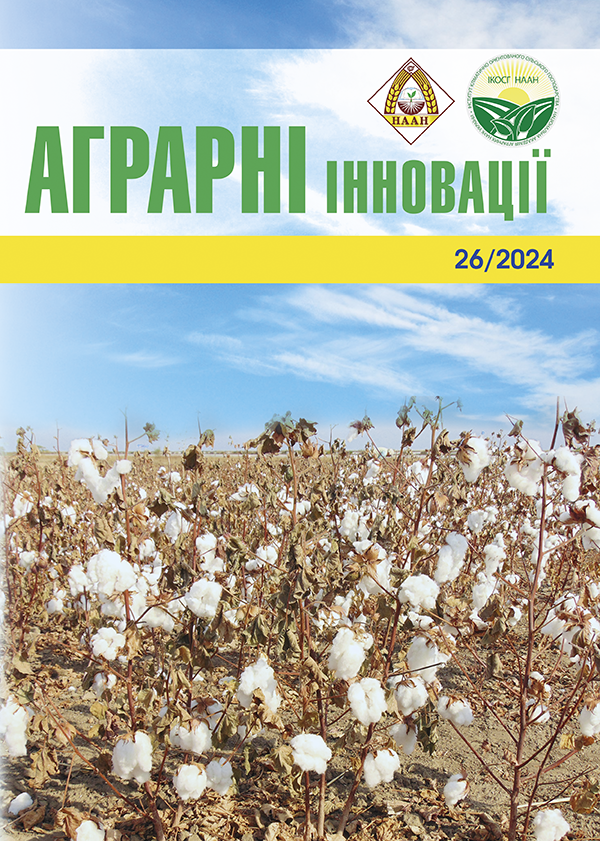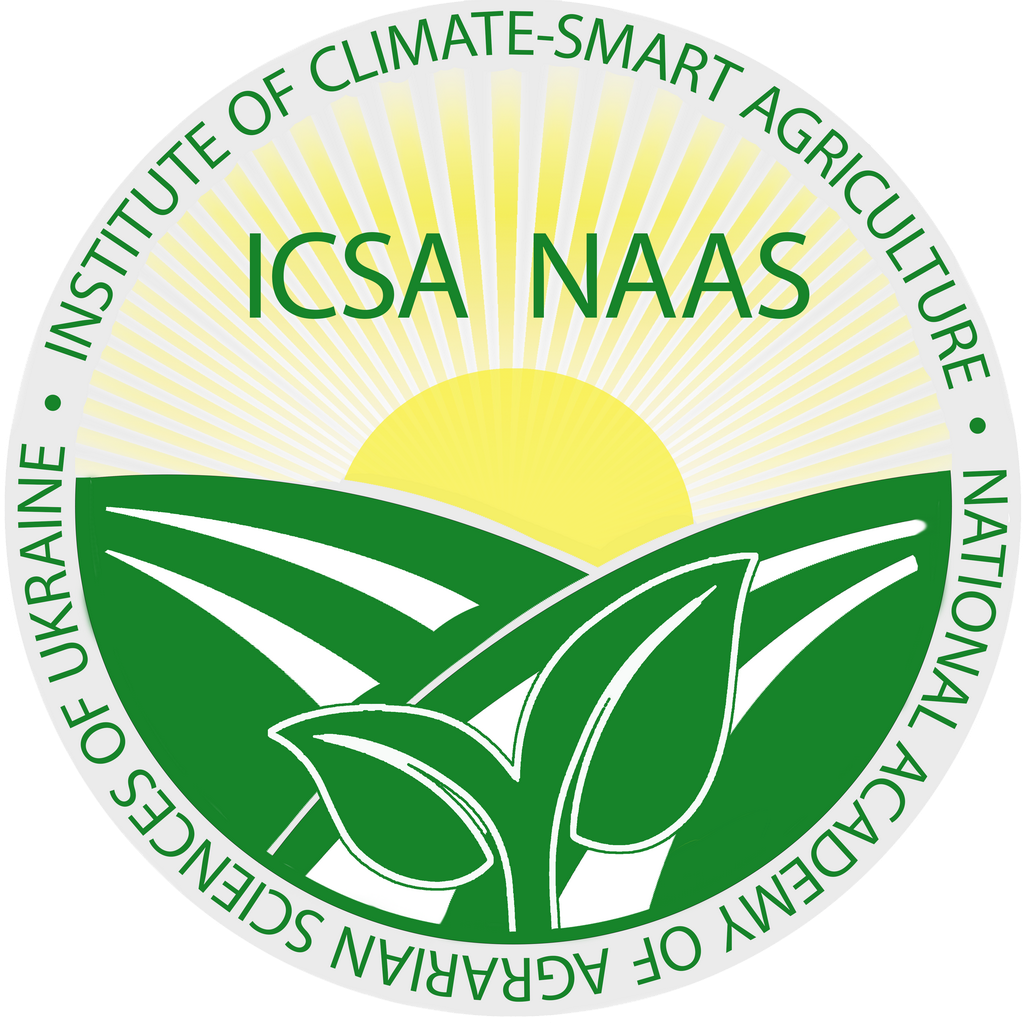WATER CONSUMPTION OF MEDICINAL HYSSOP (HYSSOPUS OFFICINALIS L.) DEPENDING ON NUTRITION OPTIMIZATION IN THE CONDITIONS OF THE SOUTHERN STEPPE OF UKRAINE
Abstract
Objective. To determine the influence of optimization of nutrition of plantations of medicinal hyssop on water consumption of the crop in the Northern Steppe of Ukraine. Methods. Field and laboratory studies were carried out in accordance with modern requirements and standards of research in agronomy and agriculture. Results. The water regime of the soil under the plantations of medicinal hyssop depended on the factors of the experiment and weather conditions of the year of study. The highest total water consumption of the plantations of medicinal hyssop was determined in the second year of use of plantations – on average, according to the variants of the experiment, 4347.5 m3/ha, which exceeded the indicators of the first and third years of use of plantations by 1704.0 – 2018.2 m3/ha or 39.2 – 46.4%. Regardless of the year of crop cultivation, the highest rates of total water consumption were noted for the use of Helaphytes combi for foliar feeding of hyssop plants twice during the growing season against the background of mineral fertilizers in a dose of N90P90 – 2477 – 4410 m3/ha, depending on the year of planting use. On average, over the years of use of hyssop plantations, the lowest coefficient of water consumption of hyssop plants was characterized by the variant of foliar fertilization of plantations twice during the growing season with Helafit combi against the background of mineral fertilizers at a dose of N90P90 – 412.2 m3/t. The most efficient use of moisture was made to create the yield of the plant of medicinal hyssop in the third year of use. Conclusions. In the conditions of arid Southern Steppe of Ukraine, when optimizing the nutrition of medicinal hyssop (combined use of mineral fertilizers in a dose of N90P90 and foliar feeding of plantations twice during the growing season with Helaphytes combi), especially in the third year of plantations use, plants more efficiently use moisture to form productivity.
References
2. Ткачова Є. С., Федорчук М. І. Морфологічні особливості гісопу лікарського. Рослинництво ХХІ столітті: виклики та інновації : матеріали ІІІ Міжнар. наук.-практ. конф. до 120-ти річчя каф. рослинництва НУБіП України, м. Київ, 25 – 27 вересня 2019 р. С. 35–37.
3. Котюк Л. Особливості мікроморфологічної будови гісопу лікарського. Modern Phytomorphology. 2016. 10. С. 59–67.
4. Степаненко С. М., Польовий А. М., Школьний Є. П. Оцінка впливу кліматичних змін на галузі економіки України. Одеса: Одеський державний екологічний університет, 2011. 696 с.
5. Roy S., Roy D. Use of medicinal plant and its vulnerability due to climate change in Northern Part of Bangladesh. American Journal of Plant Sciences. 2016. № 7. Р. 1782–1793. doi: 10.4236/ajps.2016.713166.
6. Двірна Т. С., Мінарченко В. М., Тимченко І. А. Вплив кліматичних змін на лікарські рослини. PLANTA+. НАУКА, ПРАКТИКА ТА ОСВІТА: Матеріали ІV Науково-практичної конференції з міжнародною участю, до 20-річчя кафедри фармакогнозії та ботаніки Національного медичного університету імені О. О. Богомольця, 20 лютого 2023 р. м. Київ. С. 230-233.
7. Котюк Л. Біохімічний склад інтродуцента Hyssopus officinalis L. залежно від сортових особливостей. Вісник Львівського університету. 2013. Вип. 62. С. 302–308.
8. Лиховид П. В. Зрошення в Україні з огляду на сучасну кліматичну ситуацію. The latest scientific achievements in the modern agro-industrial complex International scientific conference, December 28–29, Lublin, the Republic of Poland. Lublin, 2021. С. 20–21.
9. Моделювання врожайності гісопу лікарського (Hyssopus officinalis L.) залежно від дози та регламенту внесення мінеральних добрив / Вожегова Р.А., Коваленко О.А., Лиховид П.В., Пілярська О.О., Качанова Т.В. Зрошуване землеробство. 2023. Вип. 79. С. 18-24.
10. Ткачова Є. С., Федорчук М. І. Агробіологічні особливості гісопа лікарського (Hyssopus officinalis L.) та його значення для півдня України. Вплив змін клімату на онтогенез рослин : мат-ли доп. Міжнар. наук.-практ. конф., м. Миколаїв, 3‒5 жовтня 2018 р. Миколаїв, 2018. С. 18‒20.
11. Ghanbari-Odivi A., Fallah S., Carrubba A. Optimizing hyssop (Hyssopus officinalis L.) cultivation: effects of different manures on plant growth and essential oil yield. Horticulturae. 2024. 10(9). 894. https://doi.org/10.3390/ horticulturae10090894
12. Weather conditions influence on hyssop essential oil quality / A´cimovi´c M., Pezo L., Zeremski T., Lonˇcar B., Marjanovi´c Jeromela A. Stankovi´c Jeremic J., Cvetkovi´c M., Sikora V., Ignjatov M. Processes. 2021. 9. 1152. DOI:10.3390/pr9071152
13. Chemical composition, antimicrobial and antioxidant activities of hyssop (Hyssopus officinalis L.) essential oil / Kizil S., Hasimi N., Tolan V., Kilinc E., Karatas H. Notulae Botanicae Horti Agrobotanici Cluj-Napoca. 2010. 38. 99–103.
14. Tavakoli M., Aghajani Z. The effects of draught stress on the components of the essential oil of Hyssopus officinalis L. and determining the antioxidative properties of its water extracts. Journal of Applied Environmental and Biological Sciences. 2016. 6. 31–36.
15. Effects of agronomic practices on volatile composition of Hyssopus officinalis L. essential oils / Moro A., Zalacain A., de Mendoza J. H., Carmona M. Molecules. 2011. 16. 4131–4139.
16. Effects of exogenous application of citrulline on prolonged water stress damages in hyssop (Hyssopus officinalis L.): Antioxidant activity, biochemical indices, and essential oils profile / Ahmadi H., Babalar M., Sarcheshmeh M. A. A., Morshedloo M. R., Shokrpour M. Food Chem. 2020. 333. 127433.
17. Samany S. M. A., Pirbalouti A. G., Malekpoor F. Phytochemical and morpho-physiological changes of hyssop in response to chitosan-spraying under different levels of irrigation. Industrial Crops and Products. 2022. Vol. 176. 114330. https://doi.org/10.1016/j.indcrop. 2021.114330






